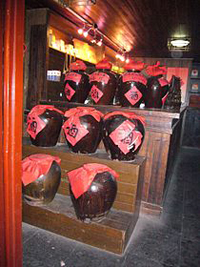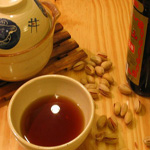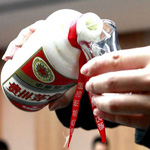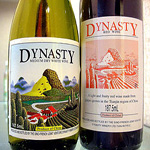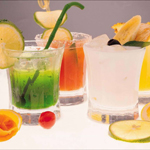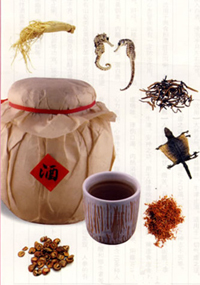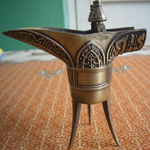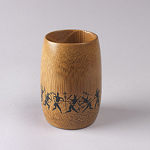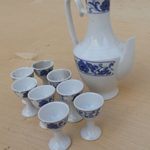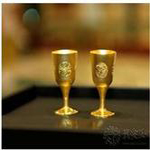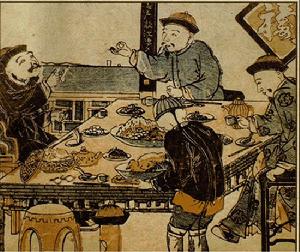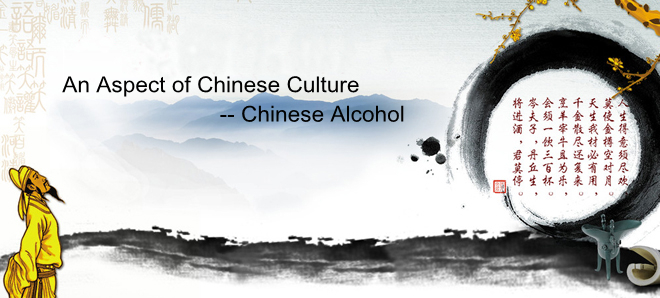
Many Chinese alcoholic drinks are quite distinctive from those of other countries and foreign visitors coming across them for the first time may a little wary of them. However, once they have tasted a sample or two, they may well acquire a taste for the various drinks available and find they really enjoy them!
| | Jiu is the Chinese word (or part of a compound word) referring to a drink or beverage containing ethanol. An important component of Chinese cuisine and culture, the use of alcohol can be traced back to the dawn of the nation's history. Over the centuries many different kinds of alcoholic drinks have been developed and brewing methods as well as distillation has become more sophisticated. At the same time the way of consuming these desirable products has become a vital part of custom and culture. |
--------------------------------------------------------------------------------------------------------------------------------------------------------------------
| | Besides the technique common in Western alcoholic beverages or else malted grains with sugar converted from starch using the grain's own enzymes (beer), Chinese jiu (and many other East Asian alcoholic beverages) are most commonly fermented from sugars converted from grain starch using enzymes from certain mold strains. The two main varieties of Chinese alcoholic beverages are fermented beverages (pinyin: huáng jiǔ; literally "yellow liquor"), which may be clear, beige, or reddish-brown in color; and distilled beverage (pinyin: bái jiǔ; literally "white liquor"), which are usually clear liquids. Although less traditional as a product, grape wine (pinyin: pútáo jiǔ; literally "grape liquor") was first mentioned in classical Chinese poems around 2,000 years ago in the Han Dynasty. It has been increasingly produced and consumed in China since 1900 as a result of increased Western influences. Kumis an alcoholic beverage produced by fermenting milk has been long known in China. |
At that time of Du Kang, millet was the main grain, the so-called "yellow liquor", then rice became more popular. It was not until the 19th century that distilled drinks became more popular. Preparation methods vary by the final type of beverage being made.
| | | | |
| Huangjiu | Baijiu | Beer | Fruit-based wines |
--------------------------------------------------------------------------------------------------------------------------------------------------------------------
Medicinal use
Sometimes there is no clear cut distinction made between alcoholic beverages and medicine, and some beverages may contain extracts of plants, herbs, animal parts, or various mineral compounds, which have or are thought to have medicinal value.
| Some of these beverages are of only of historical interest, or have only limited use. One type of a traditional alcoholic beverage containing a mineral compound is "realgar wine": on the fifth day of the fifth month of the Chinese calendar comes the holiday of the Double Fifth (Duanwu). One of the acctivities traditional in parts of China has customarily been the drinking of alcoholic beverages containing arsenic sulfide, which is potentially toxic, though in this case (usually small, annual dose) "realgar | | wine" has traditionally been thought to be medicinal: these arsenic-containing beverages, drunk on the day of the Double Fifth were regarded by the ancients as effective in preventing disease or evil and promoting health and well-being. On other occasions, this traditional arsenic compound might be put to medical use to treat parasites of the digestive system. "Realgar wine" is famous from the story Legend of the White Snake, as the substance which forced Madam White Snake to reveal her true form. |
--------------------------------------------------------------------------------------------------------------------------------------------------------------------
Way back in antiquity wine produced in China was not as we know it today. The fermented product had a thick creamy consistency and was eaten, not being suitable for drinking. Thus the vessels used were more or less the same as those used for other food such as bamboo bowls.
| | | | |
| Archeological finds dating from as early as the Neolithic Period, show that pottery had been brought into use and consequently drinking vessels were produced in a variety of forms from a simple cup to those with handles and elaborate shapes. Usually, the higher the quality are, the more dignified or important was the owner. | |||
--------------------------------------------------------------------------------------------------------------------------------------------------------------------
| As an inseparable part of alcohol culture, the practice of giving a toast has been a ritual since ancient times. Entertainment of various kinds has been offered to people who are taking a drink in order to add to their enjoyment. Performances that may include song, dance, acrobatics, etc. as well as games like 'Jiuling' (in Chinese) are all widely popular. This is highly representative of Chinese hospitality. Here we talk about Jiuling in particular, for it is unique to China.Jiuling has a long history dating back to the Western Zhou Dynasty (11th century BC - 771 BC). Originally it was introduced to regulate people's drinking habits and so ensure that they should observe rules of etiquette while not drinking to excess. | |
| It was during the Warring States Period (476 BC - 221 BC), that Jiuling evolved to include ways in which a toast could be made. This process thrived more and more until the Tang, Song, Yuan, Ming and Qing Dynasties along with the development of wine production. The Jiuling became quite fashionable and even artistic in its form thus meeting the elegance of intellectuals and the practices of the common people. | |
--------------------------------------------------------------------------------------------------------------------------------------------------------------------
| | The three main ingredients that contribute to the unique characters of various Chinese alcoholic beverages are the grains, the water, and the liquor starter. Other ingredients that alter the colour or taste of the final product may also be added. Prior to the actual brewing of the liquor, a small batch of grain is prepared to produce the seed mash. Seed mash is produced by soaking and acidifying the glutinous rice as well as other grains and steaming them on frames or screens for several minutes. This cooks the grains and converts the starch to a gelatinized form that is more easily utilized by the starter culture. |
| Chinese "yellow liquor" is sometimes distilled for a more potent alcoholic drink called baijiu, which can sometimes be as high as 70-80% alcohol. The production of baijiu is so similar in color and mouthfeel to vodka that some foreigners refer to it as "Chinese vodka" or "Chinese white vodka." However, unlike vodka, baijiu is generally distilled only once (as opposed to five or more times for some vodkas) and less thoroughly filtered, which gives each liquor its own unique and sometimes penetrating (or even somewhat harsh) flavour and fragrance. | |
Written by Nicolas Yang

